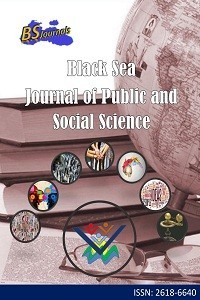The Role of the Fantastic Elements as a Means of Healing in Atkinson’s When Will There Be Good News? and Ümit’s the Dervish Gate
Fantastic, Trauma studies, Detective fiction, Ghosts, Patriarchal Cultures, Healing
The Role of the Fantastic Elements as a Means of Healing in Atkinson’s When Will There Be Good News? and Ümit’s the Dervish Gate
Fantastic, Trauma studies, Detective fiction, Ghosts, Patriarchal Cultures, Healing,
___
- Atkinson K. 2008. When will there be good news? A Novel. Little, Brown and Company, London, UK, 1st ed., pp. 352
- Atwood M. 1997. Alias Grace. Anchor, London, UK, 1st ed., pp. 468.
- Calogeras CR. 1982. Sleepwalking and the traumatic experience. Int J Psychol Anal, 63: 483-489.
- Caruth C. 1995. Trauma: explorations in memory. Johns Hopkins University Press, Baltimore, USA, 1st ed., 9780801850073.
- Caruth C. 1996. Unclaimed experience: trauma, narrative, and history. Baltimore: Johns Hopkins UP, Baltimore, USA, 1st ed., pp. 168.
- Felman S, Dori L. 1992. Testimony: Crises of witnessing in literature, psychoanalysis, and history. Taylor & Francis, London, UK, 1st ed., pp. 312..
- Gordon A. 1997. Ghostly matters: haunting and the sociological imagination. University of Minnesota Press, Minnesota, USA, 1st ed., pp. 272.
- Hamilton SC. 2015. Sara Paretsky: Detective fiction as trauma literature. Manschester University Press, Manschester, UK, 1st ed., pp. 200.
- Herman J. 1992. Trauma and recovery. Basic Books, New York, USA, 1st ed., pp. 304.
- Hogle, Jerrold E. 2002. Introduction: The Gothic in Western Culture. In: Jerrold EH editor. The Cambridge Companion to Gothic Fiction. Cambridge UP, Cambridge, UK, 1st ed., pp. 1-20. Print.
- Kenway J. 2016. The ghosts of the school curriculum: past, present, and future. Australian Educat Res, 35(2): 1-13.
- Luckhurst R. 2006. Mixing memory and desire: psychoanalysis, psychology, and trauma theory. In: Waugh P. editor. Literary theory and criticism: an Oxford guide. Oxford University Press, Oxford, UK, 1st ed., pp. 497-507. ISBN 9781405112185.
- McLewin AL, Muller TR. 2006. Childhood trauma, imaginary companions, and the development of pathological dissociation. Aggres Viol Behav, 11: 531-545.
- Punter D. 1980. The literature of terror: a history of gothic fictions from 1765 to the present day. Longmans, London, UK, 2nd ed., 978-0582237148.
- Schimmel A. 1993. The triumphal sun: a study of the works of jalāloddin rumi. State University of New York Press, New York, USA, 1st ed., pp. 513.
- Ümit A. 2012. The dervish gate. Everest Publications, İstanbul, Türkiye, 1st ed., 408.
- Van der K, Bessel A, Van der OH. The intrusive past: The flexibility of memory and the engraving of trauma. Psychoanal Culture Traum, 48(4): 425-454.
- Van der K, Bessel A. 2014. The body keeps the score: brain, mind, and body in the healing of trauma. Penguin Publishing Group, New York, USA, 1st ed., pp. 464.
- Van der K, Bessel A. van der Kolk, B. A. (1996). The complexity of adaptation to trauma: Self-regulation, stimulus discrimination, and characterological development. In van der K, McFarlane AC,
- Weisaeth L, editors. Traumatic stress: The effects of overwhelming experience on mind, body, and society. Guilford Press, New York, USA, 1st ed., pp. 182-213.
- Van der K, McFarlane AC, 2007. Traumatic stress: the effects of overwhelming experience on mind, body, and society. Guilford Press, New York, USA, 1st ed., pp. 596.
- Van der K, McFarlane, and Weisaeth. Trauma and Memory. 279-302.
- Wisker G. 2016. Contemporary women's gothic fiction. London: Palgrave Macmillan.
- Ziolkowski T. 1978. Otherworlds: Fantasy and the fantastic. The Sewanee Rev, 86: 121-129.
- Yayın Aralığı: Yıllık
- Başlangıç: 2018
- Yayıncı: Sevtap TIRINK
The Hidden Side of the Covid-19 Epidemic Process Increasing Domestic Violence
Hidayet TAŞ, İsmail YURDAKUL, Ali BOZDEMİR, Rahime Aydın ERDOĞAN, Ela ERDEN, Bilal CEYLAN
Güney Kafkasya’nın Tarihi ve Jeopolitik Önemi Üzerine Bir Değerlendirme
Orta Çağ Doğu Karadeniz Türk Tarihinin Kaynakları Üzerine Bir Değerlendirme
The Advertising Poster: What Contribution In French Lessons?
